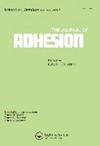用脉冲放电方法进行智能脱粘的胶粘剂的电学性能
IF 2.3
4区 材料科学
Q2 ENGINEERING, CHEMICAL
引用次数: 1
摘要
为了回收材料,需要简单的技术将聚合物粘合剂从金属上剥离。脉冲放电脱粘法是一种很有前途的解决方案。在这种方法中,在短时间内对系统施加高电压的脉冲放电。气化后的物料迅速膨胀,排出通道产生冲击波,导致脱粘。传统脉冲放电方法的缺点是必须在水中进行,否则,脉冲放电沿着材料表面蠕动而不破坏附着力。本研究在结构胶中加入填料,对金属粘附体进行脉冲放电脱粘。制备了以炭黑、铜和钛酸钡颗粒为填料的环氧树脂,研究了脉冲放电前后环氧树脂的性能和粘接强度。在环氧胶粘剂中加入3.4 vol%的炭黑,成功地引入了胶粘剂内部的脉冲放电;由于放电引起的气化附着力迅速膨胀,导致了脱胶。基于渗滤模型和实验数据,讨论了炭黑在胶粘剂内有效脉冲放电的阈值体积分数。本文章由计算机程序翻译,如有差异,请以英文原文为准。
Electrical properties of adhesives designed for smart debonding by a pulsed discharge method
ABSTRACT Facile techniques are required for the debonding of polymeric adhesives from metals for material recycling. A promising solution is a pulsed discharge debonding method. In this approach, a pulsed discharge with a high voltage is applied to the system over a short time. Rapid expansion of gasified materials and shock-wave emissions are produced from the discharge passage, which results in debonding. A drawback of the conventional pulsed discharge method is that it must be conducted in water, otherwise, the pulsed discharge creeps along the material surface without destroying the adhesion. In this study, filler was added to the structure adhesive for the effective pulsed discharge debonding of metal adherend. Epoxy resins with fillers of carbon black, copper and barium titanate particles were fabricated, and their properties and adhesive strength before and after application of the pulsed discharge were investigated. We succeeded in introducing the pulsed discharge inside the adhesive by adding 3.4 vol% of carbon black to the epoxy adhesive; the rapid expansion of gasified adhesion that was caused by the discharge, resulted in debonding. The threshold volume fraction of carbon black for effective pulsed discharge inside the adhesive was discussed based on the percolation model with experimental data.
求助全文
通过发布文献求助,成功后即可免费获取论文全文。
去求助
来源期刊

Journal of Adhesion
工程技术-材料科学:综合
CiteScore
5.30
自引率
9.10%
发文量
55
审稿时长
1 months
期刊介绍:
The Journal of Adhesion is dedicated to perpetuating understanding of the phenomenon of adhesion and its practical applications. The art of adhesion is maturing into a science that requires a broad, coordinated interdisciplinary effort to help illuminate its complex nature and numerous manifestations.
 求助内容:
求助内容: 应助结果提醒方式:
应助结果提醒方式:


